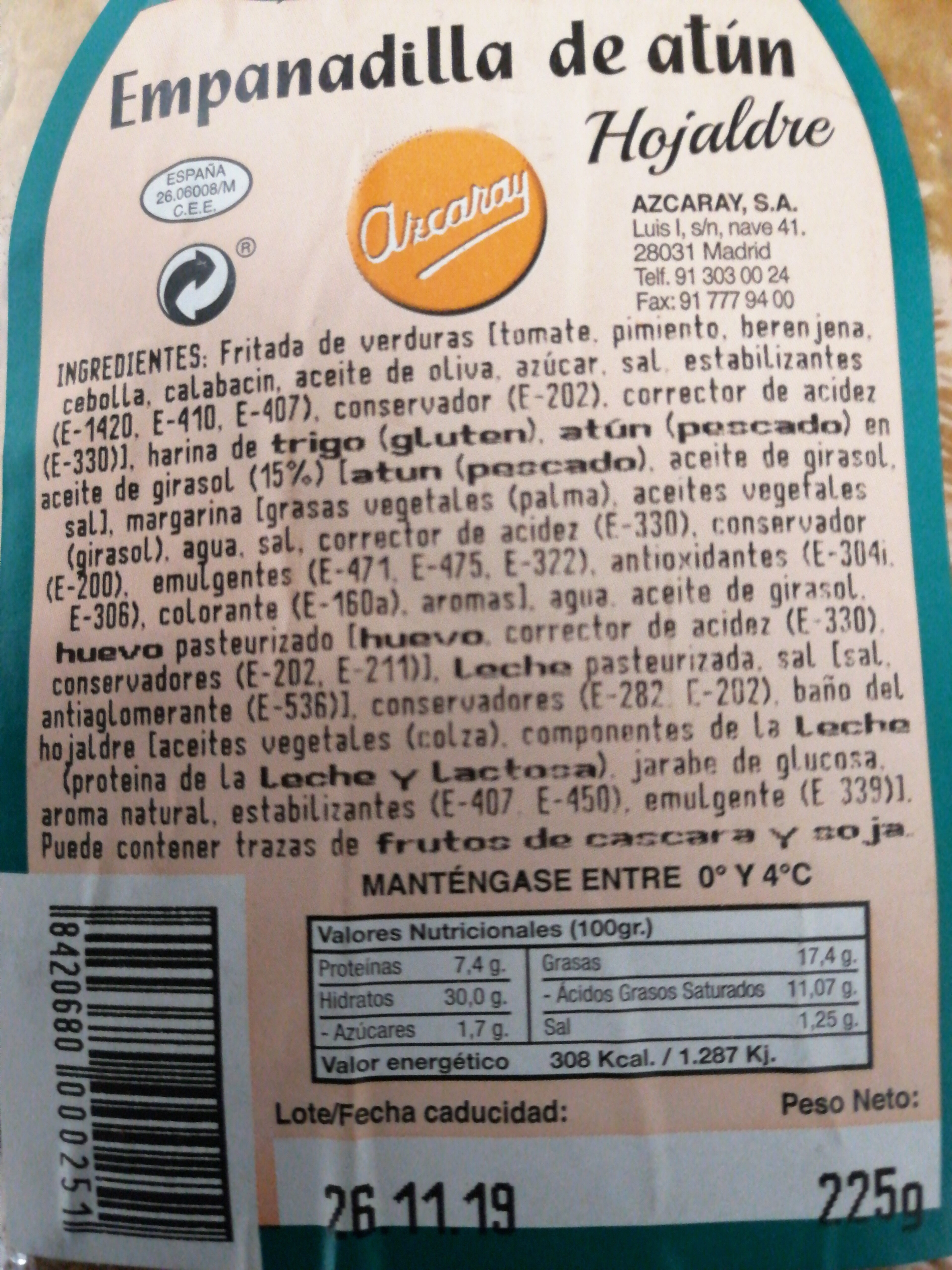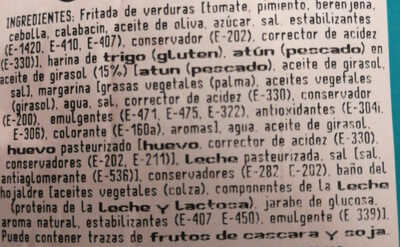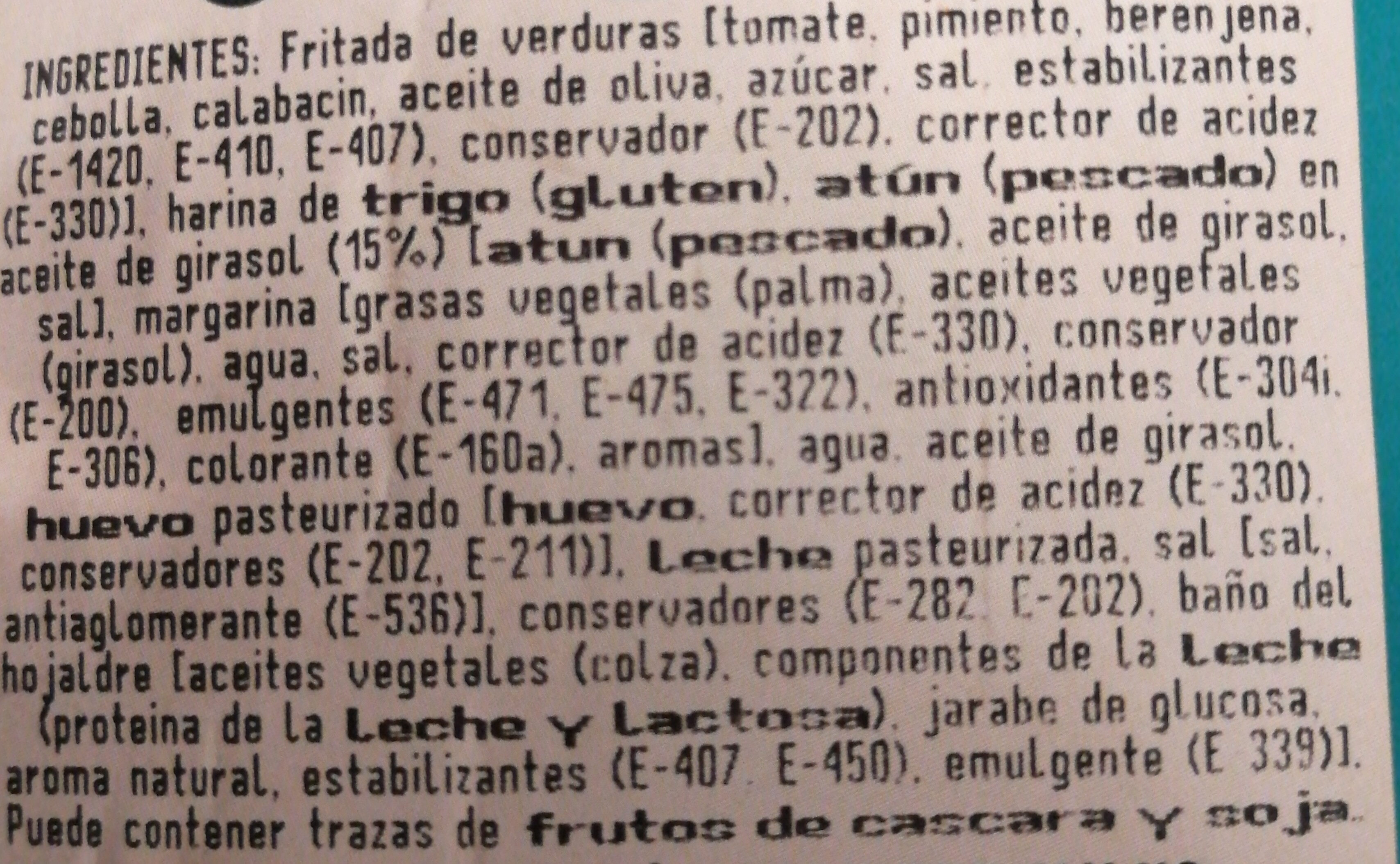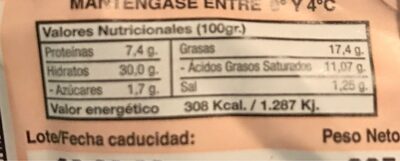Help us make food transparency the norm!
As a non-profit organization, we depend on your donations to continue informing consumers around the world about what they eat.
The food revolution starts with you!
Empanada de atún hojaldre - Azcaray - 225 g.
Empanada de atún hojaldre - Azcaray - 225 g.
This product page is not complete. You can help to complete it by editing it and adding more data from the photos we have, or by taking more photos using the app for Android or iPhone/iPad. Thank you!
×
Barcode: 8420680000251 (EAN / EAN-13)
Quantity: 225 g.
Brands: Azcaray
Categories: Meals, Pizzas pies and quiches, Salted pies, Pies, es:Empanada de atún
Stores: Alcampo
Countries where sold: Spain
Matching with your preferences
Health
Ingredients
-
74 ingredients
Spanish: Fritada de verduras [tomate, pimiento, berenjena, cebolla, calabacin, aceite de oliva, azúcar, sal, estabilizantes (E-1420. E-410, E-407), conservador (E-202). corrector de acidez (E-330)1, harina de trigo (gluten), atún (pescado) en aceite de girasol (15%) [atun (pescado), aceite de girasol. sal], margarina (grasas vegetales (palma), aceites vegetales (girasol). agua, sal, corrector de acidez (E-330), conservador (E-200), emulgentes (E-471, E-475, E-322), antioxidantes (E-304i. E-306), colorante (E-160a), aromas, agua. aceite de girasol. huevo pasteurizado [huevo, corrector de acidez (E-330). conservadores (E-202, E-211)], Leche pasteurizada, sal (sal. antiaglomerante (E-536)], conservadores (E-282. E-202). baño del hojaldre [aceites vegetales (colza), componentes de la Leche (proteina de la Leche y Lactosa). jarabe de glucosa, aroma natural, estabilizantes (E-407. E-450). emulgente (E 339)]. Puede contener trazas de frutos de cascara y soja.Allergens: Eggs, Fish, Gluten, MilkTraces: Nuts, Soybeans
Food processing
-
Ultra processed foods
Elements that indicate the product is in the 4 - Ultra processed food and drink products group:
- Additive: E1420 - Acetylated starch
- Additive: E160a - Carotene
- Additive: E322 - Lecithins
- Additive: E407 - Carrageenan
- Additive: E410 - Locust bean gum
- Additive: E450 - Diphosphates
- Additive: E471 - Mono- and diglycerides of fatty acids
- Additive: E475 - Polyglycerol esters of fatty acids
- Ingredient: Colour
- Ingredient: Emulsifier
- Ingredient: Flavouring
- Ingredient: Glucose
- Ingredient: Glucose syrup
- Ingredient: Lactose
- Ingredient: Milk proteins
Food products are classified into 4 groups according to their degree of processing:
- Unprocessed or minimally processed foods
- Processed culinary ingredients
- Processed foods
- Ultra processed foods
The determination of the group is based on the category of the product and on the ingredients it contains.
Additives
-
E160a - Carotene
Carotene: The term carotene -also carotin, from the Latin carota, "carrot"- is used for many related unsaturated hydrocarbon substances having the formula C40Hx, which are synthesized by plants but in general cannot be made by animals -with the exception of some aphids and spider mites which acquired the synthesizing genes from fungi-. Carotenes are photosynthetic pigments important for photosynthesis. Carotenes contain no oxygen atoms. They absorb ultraviolet, violet, and blue light and scatter orange or red light, and -in low concentrations- yellow light. Carotenes are responsible for the orange colour of the carrot, for which this class of chemicals is named, and for the colours of many other fruits, vegetables and fungi -for example, sweet potatoes, chanterelle and orange cantaloupe melon-. Carotenes are also responsible for the orange -but not all of the yellow- colours in dry foliage. They also -in lower concentrations- impart the yellow coloration to milk-fat and butter. Omnivorous animal species which are relatively poor converters of coloured dietary carotenoids to colourless retinoids have yellowed-coloured body fat, as a result of the carotenoid retention from the vegetable portion of their diet. The typical yellow-coloured fat of humans and chickens is a result of fat storage of carotenes from their diets. Carotenes contribute to photosynthesis by transmitting the light energy they absorb to chlorophyll. They also protect plant tissues by helping to absorb the energy from singlet oxygen, an excited form of the oxygen molecule O2 which is formed during photosynthesis. β-Carotene is composed of two retinyl groups, and is broken down in the mucosa of the human small intestine by β-carotene 15‚15'-monooxygenase to retinal, a form of vitamin A. β-Carotene can be stored in the liver and body fat and converted to retinal as needed, thus making it a form of vitamin A for humans and some other mammals. The carotenes α-carotene and γ-carotene, due to their single retinyl group -β-ionone ring-, also have some vitamin A activity -though less than β-carotene-, as does the xanthophyll carotenoid β-cryptoxanthin. All other carotenoids, including lycopene, have no beta-ring and thus no vitamin A activity -although they may have antioxidant activity and thus biological activity in other ways-. Animal species differ greatly in their ability to convert retinyl -beta-ionone- containing carotenoids to retinals. Carnivores in general are poor converters of dietary ionone-containing carotenoids. Pure carnivores such as ferrets lack β-carotene 15‚15'-monooxygenase and cannot convert any carotenoids to retinals at all -resulting in carotenes not being a form of vitamin A for this species-; while cats can convert a trace of β-carotene to retinol, although the amount is totally insufficient for meeting their daily retinol needs.Source: Wikipedia
-
E200 - Sorbic acid
Sorbic acid: Sorbic acid, or 2‚4-hexadienoic acid, is a natural organic compound used as a food preservative. It has the chemical formula CH3-CH-4CO2H. It is a colourless solid that is slightly soluble in water and sublimes readily. It was first isolated from the unripe berries of the Sorbus aucuparia -rowan tree-, hence its name.Source: Wikipedia
-
E202 - Potassium sorbate
Potassium sorbate (E202) is a synthetic food preservative commonly used to extend the shelf life of various food products.
It works by inhibiting the growth of molds, yeast, and some bacteria, preventing spoilage. When added to foods, it helps maintain their freshness and quality.
Some studies have shown that when combined with nitrites, potassium sorbate have genotoxic activity in vitro. However, potassium sorbate is generally recognized as safe (GRAS) by regulatory authorities.
-
E211 - Sodium benzoate
Sodium benzoate: Sodium benzoate is a substance which has the chemical formula NaC7H5O2. It is a widely used food preservative, with an E number of E211. It is the sodium salt of benzoic acid and exists in this form when dissolved in water. It can be produced by reacting sodium hydroxide with benzoic acid.Source: Wikipedia
-
E282 - Calcium propionate
Calcium propanoate: Calcium propanoate or calcium propionate has the formula Ca-C2H5COO-2. It is the calcium salt of propanoic acid.Source: Wikipedia
-
E304 - Fatty acid esters of ascorbic acid
Ascorbyl palmitate: Ascorbyl palmitate is an ester formed from ascorbic acid and palmitic acid creating a fat-soluble form of vitamin C. In addition to its use as a source of vitamin C, it is also used as an antioxidant food additive -E number E304-. It is approved for use as a food additive in the EU, the U.S., Canada, Australia, and New Zealand.Ascorbyl palmitate is known to be broken down -through the digestive process- into ascorbic acid and palmitic acid -a saturated fatty acid- before being absorbed into the bloodstream. Ascorbyl palmitate is also marketed as "vitamin C ester".Source: Wikipedia
-
E304i - Ascorbyl palmitate
Ascorbyl palmitate: Ascorbyl palmitate is an ester formed from ascorbic acid and palmitic acid creating a fat-soluble form of vitamin C. In addition to its use as a source of vitamin C, it is also used as an antioxidant food additive -E number E304-. It is approved for use as a food additive in the EU, the U.S., Canada, Australia, and New Zealand.Ascorbyl palmitate is known to be broken down -through the digestive process- into ascorbic acid and palmitic acid -a saturated fatty acid- before being absorbed into the bloodstream. Ascorbyl palmitate is also marketed as "vitamin C ester".Source: Wikipedia
-
E322 - Lecithins
Lecithins are natural compounds commonly used in the food industry as emulsifiers and stabilizers.
Extracted from sources like soybeans and eggs, lecithins consist of phospholipids that enhance the mixing of oil and water, ensuring smooth textures in various products like chocolates, dressings, and baked goods.
They do not present any known health risks.
-
E330 - Citric acid
Citric acid is a natural organic acid found in citrus fruits such as lemons, oranges, and limes.
It is widely used in the food industry as a flavor enhancer, acidulant, and preservative due to its tart and refreshing taste.
Citric acid is safe for consumption when used in moderation and is considered a generally recognized as safe (GRAS) food additive by regulatory agencies worldwide.
-
E339 - Sodium phosphates
Sodium phosphates: Sodium phosphate is a generic term for a variety of salts of sodium -Na+- and phosphate -PO43−-. Phosphate also forms families or condensed anions including di-, tri-, tetra-, and polyphosphates. Most of these salts are known in both anhydrous -water-free- and hydrated forms. The hydrates are more common than the anhydrous forms.Source: Wikipedia
-
E407 - Carrageenan
Carrageenan (E407), derived from red seaweed, is widely employed in the food industry as a gelling, thickening, and stabilizing agent, notably in dairy and meat products.
It can exist in various forms, each imparting distinct textural properties to food.
However, its degraded form, often referred to as poligeenan, has raised health concerns due to its potential inflammatory effects and its classification as a possible human carcinogen (Group 2B) by the International Agency for Research on Cancer (IARC).
Nevertheless, food-grade carrageenan has been deemed safe by various regulatory bodies when consumed in amounts typically found in food.
-
E410 - Locust bean gum
Locust bean gum: Locust bean gum -LBG, also known as carob gum, carob bean gum, carobin, E410- is a thickening agent and a gelling agent used in food technology.Source: Wikipedia
-
E450 - Diphosphates
Diphosphates (E450) are food additives often utilized to modify the texture of products, acting as leavening agents in baking and preventing the coagulation of canned food.
These salts can stabilize whipped cream and are also found in powdered products to maintain their flow properties. They are commonly present in baked goods, processed meats, and soft drinks.
Derived from phosphoric acid, they're part of our daily phosphate intake, which often surpasses recommended levels due to the prevalence of phosphates in processed foods and drinks.
Excessive phosphate consumption is linked to health issues, such as impaired kidney function and weakened bone health. Though diphosphates are generally regarded as safe when consumed within established acceptable daily intakes, it's imperative to monitor overall phosphate consumption to maintain optimal health.
-
E471 - Mono- and diglycerides of fatty acids
Mono- and diglycerides of fatty acids (E471), are food additives commonly used as emulsifiers in various processed foods.
These compounds consist of glycerol molecules linked to one or two fatty acid chains, which help stabilize and blend water and oil-based ingredients. E471 enhances the texture and shelf life of products like margarine, baked goods, and ice cream, ensuring a smooth and consistent texture.
It is generally considered safe for consumption within established regulatory limits.
-
E536 - Potassium ferrocyanide
Potassium ferrocyanide: Potassium ferrocyanide is the inorganic compound with formula K4[Fe-CN-6]·3H2O. It is the potassium salt of the coordination complex [Fe-CN-6]4−. This salt forms lemon-yellow monoclinic crystals.Source: Wikipedia
Ingredients analysis
-
Palm oil
Ingredients that contain palm oil: Palm
-
Non-vegan
Non-vegan ingredients: Tuna, Tuna, Egg, Egg, Pasteurised milk, Lactose and milk proteinsSome ingredients could not be recognized.
We need your help!
You can help us recognize more ingredients and better analyze the list of ingredients for this product and others:
- Edit this product page to correct spelling mistakes in the ingredients list, and/or to remove ingredients in other languages and sentences that are not related to the ingredients.
- Add new entries, synonyms or translations to our multilingual lists of ingredients, ingredient processing methods, and labels.
If you would like to help, join the #ingredients channel on our Slack discussion space and/or learn about ingredients analysis on our wiki. Thank you!
-
Non-vegetarian
Non-vegetarian ingredients: Tuna, TunaSome ingredients could not be recognized.
We need your help!
You can help us recognize more ingredients and better analyze the list of ingredients for this product and others:
- Edit this product page to correct spelling mistakes in the ingredients list, and/or to remove ingredients in other languages and sentences that are not related to the ingredients.
- Add new entries, synonyms or translations to our multilingual lists of ingredients, ingredient processing methods, and labels.
If you would like to help, join the #ingredients channel on our Slack discussion space and/or learn about ingredients analysis on our wiki. Thank you!
-
Details of the analysis of the ingredients
We need your help!
Some ingredients could not be recognized.
We need your help!
You can help us recognize more ingredients and better analyze the list of ingredients for this product and others:
- Edit this product page to correct spelling mistakes in the ingredients list, and/or to remove ingredients in other languages and sentences that are not related to the ingredients.
- Add new entries, synonyms or translations to our multilingual lists of ingredients, ingredient processing methods, and labels.
If you would like to help, join the #ingredients channel on our Slack discussion space and/or learn about ingredients analysis on our wiki. Thank you!
es: Fritada de verduras (tomate, pimiento, berenjena, cebolla, calabacin, aceite de oliva, azúcar, sal, estabilizantes (e1420, e410, e407), conservador (e202), corrector de acidez (e330), 1, harina de trigo, atún, en aceite de girasol 15%, atun, aceite de girasol, sal), margarina, grasas vegetales (palma), aceites vegetales (girasol), agua, sal, corrector de acidez (e330), conservador (e200), emulgentes (e471, e475, e322), antioxidantes (e304i, e306), colorante (e160a), aromas, agua, aceite de girasol, huevo (huevo, corrector de acidez (e330), conservadores (e202, e211)), Leche pasteurizada, sal, sal, antiaglomerante (e536), conservadores (e282, e202), baño del hojaldre (aceites vegetales (colza), componentes de la Leche (proteina de la Leche y Lactosa), jarabe de glucosa, aroma natural, estabilizantes (e407, e450), emulgente (e339))- Fritada de verduras -> es:fritada-de-verduras
- tomate -> en:tomato - vegan: yes - vegetarian: yes - ciqual_food_code: 20047
- pimiento -> en:bell-pepper - vegan: yes - vegetarian: yes - ciqual_food_code: 20041
- berenjena -> en:aubergine - vegan: yes - vegetarian: yes - ciqual_food_code: 20053
- cebolla -> en:onion - vegan: yes - vegetarian: yes - ciqual_food_code: 20034
- calabacin -> en:courgette - vegan: yes - vegetarian: yes - ciqual_food_code: 20020
- aceite de oliva -> en:olive-oil - vegan: yes - vegetarian: yes - from_palm_oil: no - ciqual_proxy_food_code: 17270
- azúcar -> en:sugar - vegan: yes - vegetarian: yes - ciqual_proxy_food_code: 31016
- sal -> en:salt - vegan: yes - vegetarian: yes - ciqual_food_code: 11058
- estabilizantes -> en:stabiliser
- e1420 -> en:e1420 - vegan: yes - vegetarian: yes
- e410 -> en:e410 - vegan: yes - vegetarian: yes
- e407 -> en:e407 - vegan: yes - vegetarian: yes
- conservador -> en:preservative
- e202 -> en:e202 - vegan: yes - vegetarian: yes
- corrector de acidez -> en:acidity-regulator
- e330 -> en:e330 - vegan: yes - vegetarian: yes
- 1 -> es:1
- harina de trigo -> en:wheat-flour - vegan: yes - vegetarian: yes - ciqual_proxy_food_code: 9410
- atún -> en:tuna - vegan: no - vegetarian: no - ciqual_food_code: 26053
- en aceite de girasol -> en:sunflower-oil - vegan: yes - vegetarian: yes - from_palm_oil: no - ciqual_food_code: 17440 - percent: 15
- atun -> en:tuna - vegan: no - vegetarian: no - ciqual_food_code: 26053
- aceite de girasol -> en:sunflower-oil - vegan: yes - vegetarian: yes - from_palm_oil: no - ciqual_food_code: 17440
- sal -> en:salt - vegan: yes - vegetarian: yes - ciqual_food_code: 11058
- margarina -> en:margarine
- grasas vegetales -> en:vegetable-fat - vegan: yes - vegetarian: yes - from_palm_oil: maybe
- palma -> en:palm - vegan: yes - vegetarian: yes - from_palm_oil: yes - ciqual_food_code: 16129
- aceites vegetales -> en:vegetable-oil - vegan: yes - vegetarian: yes - from_palm_oil: maybe
- girasol -> en:sunflower - vegan: yes - vegetarian: yes
- agua -> en:water - vegan: yes - vegetarian: yes - ciqual_food_code: 18066
- sal -> en:salt - vegan: yes - vegetarian: yes - ciqual_food_code: 11058
- corrector de acidez -> en:acidity-regulator
- e330 -> en:e330 - vegan: yes - vegetarian: yes
- conservador -> en:preservative
- e200 -> en:e200 - vegan: yes - vegetarian: yes
- emulgentes -> en:emulsifier
- e471 -> en:e471 - vegan: maybe - vegetarian: maybe - from_palm_oil: maybe
- e475 -> en:e475 - vegan: maybe - vegetarian: maybe
- e322 -> en:e322 - vegan: maybe - vegetarian: maybe
- antioxidantes -> en:antioxidant
- e304i -> en:e304i - vegan: yes - vegetarian: yes - from_palm_oil: maybe
- e306 -> en:e306 - vegan: yes - vegetarian: yes
- colorante -> en:colour
- e160a -> en:e160a - vegan: maybe - vegetarian: maybe - from_palm_oil: maybe
- aromas -> en:flavouring - vegan: maybe - vegetarian: maybe
- agua -> en:water - vegan: yes - vegetarian: yes - ciqual_food_code: 18066
- aceite de girasol -> en:sunflower-oil - vegan: yes - vegetarian: yes - from_palm_oil: no - ciqual_food_code: 17440
- huevo -> en:egg - vegan: no - vegetarian: yes - ciqual_food_code: 22000
- huevo -> en:egg - vegan: no - vegetarian: yes - ciqual_food_code: 22000
- corrector de acidez -> en:acidity-regulator
- e330 -> en:e330 - vegan: yes - vegetarian: yes
- conservadores -> en:preservative
- e202 -> en:e202 - vegan: yes - vegetarian: yes
- e211 -> en:e211 - vegan: yes - vegetarian: yes
- Leche pasteurizada -> en:pasteurised-milk - vegan: no - vegetarian: yes - ciqual_proxy_food_code: 19051
- sal -> en:salt - vegan: yes - vegetarian: yes - ciqual_food_code: 11058
- sal -> en:salt - vegan: yes - vegetarian: yes - ciqual_food_code: 11058
- antiaglomerante -> en:anti-caking-agent
- e536 -> en:e536 - vegan: yes - vegetarian: yes
- conservadores -> en:preservative
- e282 -> en:e282 - vegan: yes - vegetarian: yes
- e202 -> en:e202 - vegan: yes - vegetarian: yes
- baño del hojaldre -> es:bano-del-hojaldre
- aceites vegetales -> en:vegetable-oil - vegan: yes - vegetarian: yes - from_palm_oil: maybe
- colza -> en:rapeseed - vegan: yes - vegetarian: yes
- componentes de la Leche -> es:componentes-de-la-leche
- proteina de la Leche y Lactosa -> en:lactose-and-milk-proteins - vegan: no - vegetarian: yes
- jarabe de glucosa -> en:glucose-syrup - vegan: yes - vegetarian: yes - ciqual_proxy_food_code: 31016
- aroma natural -> en:natural-flavouring - vegan: maybe - vegetarian: maybe
- estabilizantes -> en:stabiliser
- e407 -> en:e407 - vegan: yes - vegetarian: yes
- e450 -> en:e450 - vegan: yes - vegetarian: yes
- emulgente -> en:emulsifier
- e339 -> en:e339 - vegan: yes - vegetarian: yes
- aceites vegetales -> en:vegetable-oil - vegan: yes - vegetarian: yes - from_palm_oil: maybe
Nutrition
-
Poor nutritional quality
⚠ ️Warning: the amount of fiber is not specified, their possible positive contribution to the grade could not be taken into account.⚠ ️Warning: the amount of fruits, vegetables and nuts is not specified on the label, it was estimated from the list of ingredients: 49This product is not considered a beverage for the calculation of the Nutri-Score.
Positive points: 1
- Proteins: 4 / 5 (value: 7.4, rounded value: 7.4)
- Fiber: 0 / 5 (value: 0, rounded value: 0)
- Fruits, vegetables, nuts, and colza/walnut/olive oils: 1 / 5 (value: 49.2187976837158, rounded value: 49.2)
Negative points: 18
- Energy: 3 / 10 (value: 1289, rounded value: 1289)
- Sugars: 0 / 10 (value: 1.7, rounded value: 1.7)
- Saturated fat: 10 / 10 (value: 11.07, rounded value: 11.1)
- Sodium: 5 / 10 (value: 500, rounded value: 500)
The points for proteins are not counted because the negative points are greater or equal to 11.
Nutritional score: (18 - 1)
Nutri-Score:
-
Nutrient levels
-
Fat in moderate quantity (17.4%)
What you need to know- A high consumption of fat, especially saturated fats, can raise cholesterol, which increases the risk of heart diseases.
Recommendation: Limit the consumption of fat and saturated fat- Choose products with lower fat and saturated fat content.
-
Saturated fat in high quantity (11.1%)
What you need to know- A high consumption of fat, especially saturated fats, can raise cholesterol, which increases the risk of heart diseases.
Recommendation: Limit the consumption of fat and saturated fat- Choose products with lower fat and saturated fat content.
-
Sugars in low quantity (1.7%)
What you need to know- A high consumption of sugar can cause weight gain and tooth decay. It also augments the risk of type 2 diabetes and cardio-vascular diseases.
Recommendation: Limit the consumption of sugar and sugary drinks- Sugary drinks (such as sodas, fruit beverages, and fruit juices and nectars) should be limited as much as possible (no more than 1 glass a day).
- Choose products with lower sugar content and reduce the consumption of products with added sugars.
-
Salt in moderate quantity (1.25%)
What you need to know- A high consumption of salt (or sodium) can cause raised blood pressure, which can increase the risk of heart disease and stroke.
- Many people who have high blood pressure do not know it, as there are often no symptoms.
- Most people consume too much salt (on average 9 to 12 grams per day), around twice the recommended maximum level of intake.
Recommendation: Limit the consumption of salt and salted food- Reduce the quantity of salt used when cooking, and don't salt again at the table.
- Limit the consumption of salty snacks and choose products with lower salt content.
-
-
Nutrition facts
Nutrition facts As sold
for 100 g / 100 mlAs sold
per serving (225g)Compared to: es:Empanada de atún Energy 1,289 kj
(308 kcal)2,900 kj
(693 kcal)+25% Fat 17.4 g 39.1 g +46% Saturated fat 11.07 g 24.9 g +228% Carbohydrates 30 g 67.5 g +8% Sugars 1.7 g 3.83 g -42% Fiber ? ? Proteins 7.4 g 16.7 g - Salt 1.25 g 2.81 g +26% Fruits‚ vegetables‚ nuts and rapeseed‚ walnut and olive oils (estimate from ingredients list analysis) 49.219 % 49.219 %
Environment
-
Eco-Score not computed - Unknown environmental impact
We could not compute the Eco-Score of this product as it is missing some data, could you help complete it?Could you add a precise product category so that we can compute the Eco-Score? Add a category
Packaging
-
Missing packaging information for this product
⚠ ️ The information about the packaging of this product is not filled in.Take a photo of the recycling information Take a photo of the recycling information
Transportation
-
Origins of ingredients
Missing origins of ingredients information
⚠ ️ The origins of the ingredients of this product are not indicated.
If they are indicated on the packaging, you can modify the product sheet and add them.
If you are the manufacturer of this product, you can send us the information with our free platform for producers.Add the origins of ingredients for this product Add the origins of ingredients for this product
Threatened species
-
Contains palm oil
Drives deforestation and threatens species such as the orangutan
Tropical forests in Asia, Africa and Latin America are destroyed to create and expand oil palm tree plantations. The deforestation contributes to climate change, and it endangers species such as the orangutan, the pigmy elephant and the Sumatran rhino.
Report a problem
-
Incomplete or incorrect information?
Category, labels, ingredients, allergens, nutritional information, photos etc.
If the information does not match the information on the packaging, please complete or correct it. Open Food Facts is a collaborative database, and every contribution is useful for all.
Data sources
Product added on by openfoodfacts-contributors
Last edit of product page on by thaialagata.
Product page also edited by acuario, ecoscore-impact-estimator, kiliweb, roboto-app, teolemon, yuka.YmY4OVRiMHd0S0Ftdi9GbDFCUDEzTlZ4eTY3eFJVaXREY2s3SVE9PQ.











